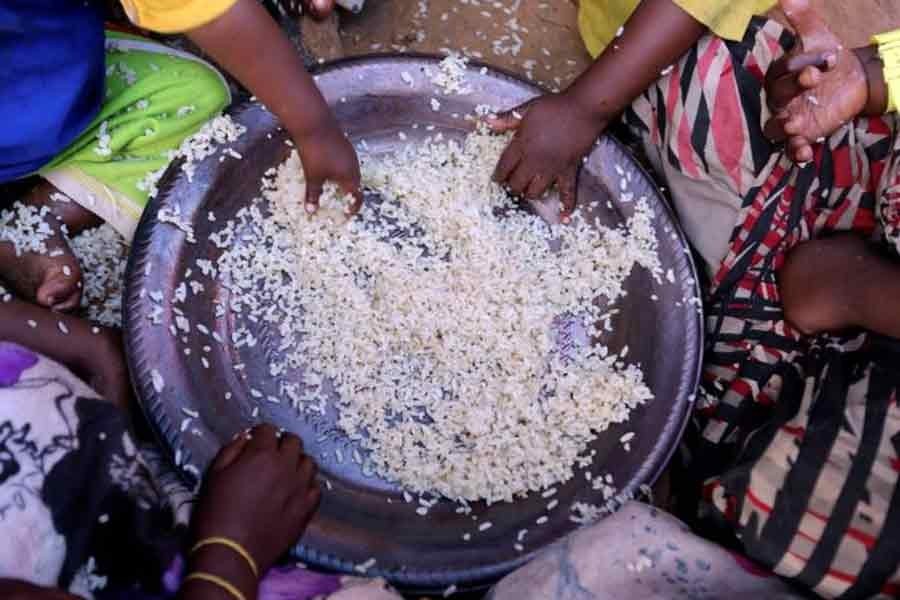A study titled, "Impact of climate change on livelihoods & its alternative solutions for the people living in south-west coastal & slum areas in Bangladesh" has come up with findings quite unsettling if not surprising. The three-month study conducted between September and November, 2022 in three unions of Shyamnagar Upazila and five slums of Satkhira Municipality finds that 30 per cent of the people under the study had to slash their food intake and an equal number could not afford foods other than rice and lentil. Given the plight of the low-income people in the post-pandemic time, particularly following Ukraine war, this is nothing exceptional either.
What is commendable is that Educo Bangladesh and Uttaran ---one a Spain-based international development and humanitarian NGO and the other a local one respectively---have undertaken a project, "Strengthening the capacity of those displaced by disasters and climate-related causes to cope with adverse situations". The title of the project speaks for itself and it necessitated some insight into the kind of vulnerabilities before developing a recipe for the people affected.
Sure enough, any rehabilitation programme for people who are better known as internal climate refugees is more welcome than just distribution of regular or occasional relief goods. According to the World Health Organisation, 7.2 million people have been displaced in 2022 alone and by 2050, the number of such people is projected to rise to 13.30 million. Satkhira's climate refugees, however, are not an entirely direct outcome of climate change. A complex socio-economic equation between greedy influential people and poor innocent farmers over shrimp enclosures mostly led to a friction and degradation of cultivable land. This is mostly responsible for the migration of farming families to slums in the south-western coastal district.
The long-standing water-logging in Bhabadah area affecting at least 1.0 million people of 200 villages is part climate change-induced and part man-made. It is an intriguing situation there as the embankment was constructed there to stop intrusion of saline water. It stopped saline water to the beel (swamp) but following the construction of embankment and sluice gates, the rivers started drying up and the natural flow of currents hampered. The saga of water-logging continues and many inhabitants had to leave their ancestral homes there.
Bangladesh's coastal areas are likely to suffer more such reversals and the country with a small geographical area will have to encounter the problem of more people's settlement. The programme the Educo and Uttaran are implementing is vastly important for the livelihood options they might prescribe for the internal refugees. Through trial and further improvement, the adaptation capacity of the affected people may be enhanced. Of course, the rehabilitation programme has two parts---those who somehow stay notwithstanding the adverse impact and those who had to leave to an urban location looking for occupations new to them.
If the affected areas are not as uninhabitable as Bhabadah, possibly there can still be made some arrangement for some people to stay put where they were born and brought up. In that case, advanced cropping system and innovative technologies will have to be introduced for them to maintain their livelihoods. Saline-tolerant crops are already there. But there still seems to be some gap between rhetoric and reality or else, farmers in this country who are always ready to accept every new art of the trade would not be found wanting to respond promptly.
There is no hard and fast rule that farmers would only cultivate saline-tolerant paddy; they can very well go for other cash crops if those prove profitable from the point of agricultural economy. If an entire village named Gadkhali can live on growing flowers round the year, there is no reason why a suitable cash crop cannot be found to alleviate the problem of saline-infested land. In some southern coastal areas, cultivation of sunflower and soybean has proved highly successful.
Next comes the question of diversification of occupation for farmers who have to move to urban locations. Sure enough, illiterate villagers coming to Dhaka take up trades that were completely unfamiliar to them before. If they are given orientation, organised training and financial assistance, the displaced people---particularly the youth among them ---can learn almost all trades. From shop-keeping to small enterprises ---everything will be made accessible to them by organisations like Educo and Uttaran. Even the government can initiate public-private small and medium enterprises especially for the internal refugees within their unions and upazilas.
The livelihood options have to be made without gender bias in order to extend the range and scope of work patterns. There are areas where women are specially gifted to contribute more to output. Thus investment, although not massive, will have to be made for creation of livelihood opportunities. The Rohingya refugees have put an undesirable extra pressure on the country's economy, environment and social relations. Rehabilitation programme for the internal refugees is unlikely to require such massive preparation and investment as yet. If the problem is addressed in a systematic manner, it can be solved without allowing it to unfold as an extensive humanitarian crisis. Let the process get going straight away.


